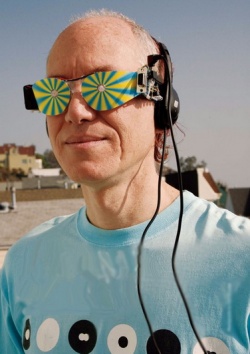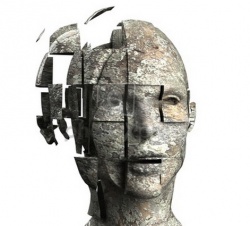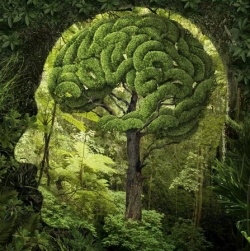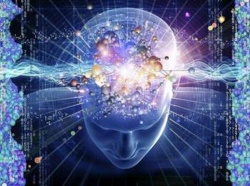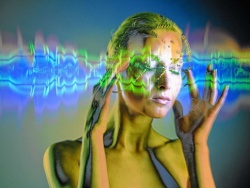Visualization
Visualization The visualizations [in the Meditation Sutra are distinguished into sixteen kinds [shifting from earthly scenes to Pure Land scenes at the third Visualization:
(1) visualization of the sun,
(2) visualization of water,
(3) visualization of the ground [in the Pure Land,
(4) visualization of the trees,
(5) visualization of the lake[s],
(6) unified visualization of the [50 billion] storied-pavilions, trees, lakes, and so forth,
(7) visualization of the lotus throne of Amitabha Buddha,
(8) visualization of the images of the Buddha Amitabha and Bodhisattvas Avalokitesvara and Mahasthamaprapta,
(9) visualization of the Reward body of Amitabha Buddha, i.e., the form in which He appears in the Pure Land,
(10) visualization of Avalokitesvara,
(11) visualization of Mahasthamaprapta,
(12) visualization of one's own rebirth,
(13) [see below],
(14) visualization of the rebirth of the highest grades,
(15) visualization of the rebirth of the middle grades and
(16) visualization of the rebirth of the lowest grades. (K.K. Tanaka, The Dawn of Chinese Pure Land Doctrine.)
The 13th Visualization has been summarized as follows:
If one cannot visualize the Reward body of Amitabha Buddha, focus on the small body, which is sixteen cubits high (the traditional height of Shakyamuni while he dwelt on earth); contemplate an intermingling of the [Reward] and small bodies. (1oji Okazaki, p.52.)
Visualizations 14-16 refer to the nine lotus grades (of rebirth), divided into three sets of three grades each.
See; Meditation Sutra for explanation.
1. To form a mental image of; envisage: tried to visualize the scene as it was described.
2. To make visible.
v.intr.
To form a mental image.
1. the act or an instance of visualizing
2. (Psychology) a technique involving focusing on positive mental images in order to achieve a particular goal
visualization refers to the practice of seeking to affect the outer world by changing one's thoughts and expectations. ; a practice that stems from the Hindu Monistic theory of the Universe.
Visualization Means Working with the Imagination
Visual metaphors, visionary literature, and visualization practices are pervasive in Buddhist traditions. Vision and seeing are dominant metaphors for knowledge, awakening, and insight: the Buddha has various supernormal “eyes” with which he can see, for example, the past and future; upon attaining awakening, the Buddha “saw” the entire process of the dependent arising of all conditions in the world; meditation allows one to “see” things as they are. Seeing in this sense often suggests incisive knowledge that penetrates delusions and conceptual fabrications apprehending the truth as it is. In Mahayana and tantric traditions, these pervasive visual metaphors contribute to the emergence of visionary literature and meditative/devotional practices that use the visual imagination. These include practices in which the practitioner envisions a buddha or bodhisattva as a kind of visualized icon to worship or receive teachings. Visualizations in the Pure Land schools are performed in order to gain rebirth in a buddha’s purified realm. Tantric Buddhism contains often elaborate visualizations of buddhas and bodhisattvas, and frequently practitioners are instructed to visualize themselves as these deities. Tantric practices also include visualizations of the interior of the body in order to manipulate the energies of the body and mind.
The topic for this evening is visualization and its place in Tibetan Buddhist practice. One of the things that characterize the Tibetan form of Buddhism is its extensive use of visualization, much more than in any other form of Buddhism. Of course all these methods developed in India, but Buddhism there died out.
In order to understand the various levels and usages of visualization, first we need to throw the word visualization out of the window. It is the wrong word because the word visualization implies something visual. In other words, it implies working with visual images and it also implies working with our eyes. This is incorrect. Instead, we are working with the imagination. When we work with the imagination we’re not only working with imagined sights, but also with imagined sounds, smells, physical sensations, feelings - emotional feelings - and so on. Obviously, we do that with our minds, not with our eyes. If we think of the Western psychological division of the brain into a right side and a left side, Tibetan Buddhism develops both sides - both the intellectual, rational side and the side of creative imagination. Therefore, when we speak of visualization in Buddhism, we’re not talking about some magical process. We’re talking about something quite practical, in terms of how to develop and use all our potentials, because we have potentials on both the right and left sides of the brain. When we work with the imagination, we’re dealing with creativity, artistic aspects and so on.
We work with the imagination on many different levels. We can divide these into sutra methods and tantra methods. Of these two, those of tantra are the most advanced.
Visualization Methods in Sutra
In sutra, we use our imaginations first of all to help us overcome negative aspects of ourselves, in other words, disturbing emotions and attitudes. If we are very much under the control of obsessive desires, let’s say desire for young attractive looking people as sexual objects, we would then try to imagine what these persons will look like when they are 80 years old. Remember, obsessive desire is based on exaggerating someone’s qualities, and so when we have this sexual desire we’re imagining that this person is going to look young and beautiful forever, which obviously is not true. Imagining [[]]what the person’s going to look like when old and decrepit, fat, and so on helps us to have a much more realistic attitude toward the person and to relate to him or her as a person rather than as a young body. This is one usage of the imagination, and as you can see, it’s creative: it’s artistic and very helpful.
Likewise, we can use our imaginations to help us to develop positive qualities, such as compassion. For instance, we can imagine a sheep about to be slaughtered and imagine ourselves as that sheep about to be slaughtered, and how we would desperately want to be free from that fate. Then we could imagine our mother, our father, our friends, and so on as this sheep. This helps us to develop a strong wish that they be free of having to be killed as well. And eventually we think about the sheep itself that is to be slaughtered. In this way, we open our hearts out to developing more compassion for others and wishing they be free from suffering.
In the sutra path there’s a tremendous variety of things that we imagine to help us overcome negative qualities, develop good qualities, and become more realistic. Like, for example, imagining if we were to die right now, would we really be emotionally prepared for that?
How to Visualize
Many people say, “Well, I can’t visualize. So how can I use these methods?” Actually, if we take a moment to investigate, we find that we all do have powers of imagination. For instance, try to remember what your mother or your best friend, it doesn’t matter who, looks like. Please do that for a moment. We all are capable of remembering what our most closely loved ones look like. So, we are able to visualize.
I remember once I was in India with a friend of mine who really had a problem with visualizing. We were on a long bus ride together on a very hot day and she was suffering very much from heat and thirst. So I started to torture her in a sense by saying, “Wow, wouldn’t it be great if we had some nice cold oranges. Can you imagine how refreshing they would taste? And their smell?” And all of a sudden she discovered that she was able to visualize and imagine an orange very well. So, we all are capable; it’s just a matter of training.
Another use of imagination in sutra is imagining a Buddha in front of us as an object of focus to gain perfect concentration. The sutra path is divided into the Hinayana and Mahayana, the “modest vehicle of mind” and the “vast vehicle of mind.” In the Hinayana schools, the usual way to develop absorbed concentration is to focus on the breath, which uses sense consciousness. We focus on the physical sensation of the breath going in and out of the nose. Mahayana, however, points out that we have to consider what are we using the concentration for. We’re using it to be able to focus on reality with concentration and to stay focused on feelings of love and compassion. Therefore, what we want to be able to do is to concentrate with our mental consciousness, not with our sense consciousness. And so, in Mahayana, the preferred way of developing concentration is on an imagined Buddha.
When we imagine a Buddha, we imagine a very small Buddha-figure in front of us at the level of our eyes, about an arm’s length away, and we imagine this figure to be not solid, but made out of light, and alive. We imagine that there’s a little bit of corporeality - some weight for that light – this is just a little trick to help keeping that image stable. If we think too much in terms of it being just light, the image tends to float around too easily. What’s important in working with this type of visualization practice is that we don’t focus with our eyes staring ahead as if we were looking at the Buddha in front of us. Rather, we look down toward the floor and imagine something in front of us at the level of our brow. Try that for a moment. Look down in front of you and hold your hand in front at the level of your eyes. Now, while looking down at the floor, you can concentrate where your hand is and imagine that your hand is there, even though you are not seeing it, can’t you? So, it is possible. That’s what we do when we visualize a figure in front of us.
But, we’re not just imagining an apple in front of us, we’re imagining a Buddha. This is very significant because in Buddhism, as you know, we tend to do many things simultaneously. By focusing on a Buddha to gain concentration, we also focus on the qualities of a Buddha. This helps us to keep our perfect concentration on those qualities as well. What’s more, by focusing on a Buddha, our concentration can be accompanied with a very strong taking of refuge. In other words, “This is the safe direction I want to go in my life.” We can accompany our concentration with a bodhichitta aim as well, in other words, “I want to become a Buddha like this figure I’m imagining in order to be able to benefit everyone.” If we can accomplish perfect concentration on the figure of a Buddha, keeping in mind the qualities of a Buddha, and we want to go in the safe direction a Buddha indicates and become a Buddha ourselves in order to help everybody – if that’s the package that we’re gaining concentration on – then that has much more far-reaching benefits that just concentrating on the sensation of the breath going in and out of our nose. So, this is a vast method. That’s why we call it “Mahayana”: a vast vehicle of training through vast techniques.
Visualization Methods in Tantra
Tantra is the main area in which we find the use of imagination, and so the rest of this talk is going to be about tantra. I think that even if we’re not yet involved in tantric practice, or don’t even have an intention to be involved with tantric practice at this point in our Dharma training, it can be very helpful to have some idea of what goes on in tantra practice. This will help us to dispel any misconceptions we might have about it, such as it’s all magic, exotic sex, and that sort of stuff. Having a clearer idea of what it is helps us to decide on a more rational basis whether or not we would really like to involve ourselves with this level of practice.
The use of imagination in tantra is a very sophisticated topic, so I’d like to present it in a fairly sophisticated way. Let’s start on a general level. In tantra, we use our imaginations to imagine various Buddha-figures, yidam (yi-dam) in Tibetan. These Buddha-figures are sometimes referred to as “deities,” although the Tibetan term being translated here, lhag-pay lha (lhag-pa’i lha), actually means “higher deities.” They are higher in the sense that they are not samsaric gods in a samsaric god-realm, but are beyond the uncontrollably recurring rebirth of limited beings. So, they’re not creator gods and they’re not like ancient Greek gods or anything of the sort. Rather, all these figures represent the full enlightenment of a Buddha and each of them also represents prominently a particular aspect of Buddhahood, like Chenrezig or Avalokiteshvara embodying compassion and Manjushri embodying discriminating awareness or wisdom.
When we work with these Buddha-figures, we either imagine them in front of us or on top of our heads or, more frequently, we imagine ourselves in the form of one of them.
“Clarity” and “Pride”
When we imagine these figures, we need to work on two aspects simultaneously. These are usually translated as “clarity” and “pride.” This is somewhat misleading. One of the biggest problems that we face as Westerners dealing with Buddhism is that most of the translation terms are misleading.
First of all, “clarity” doesn’t mean what we usually understand clarity to mean. The word translated as clarity here doesn’t mean “in focus,” but rather it means “having or making something appear.” This means that our minds actually make an image appear. That’s one side of the story we have to work on, getting an image to appear. When we work with these figures, what we try to do is to focus on what our minds make appear and, as our concentration develops, then the focus, the details, will improve automatically. There is no need to strain to get all the details and everything in focus. To start with, all we need is a rough image of something appearing, even if it is just a ball of light.
The second aspect, “pride,” doesn’t mean arrogance. Rather, it means feeling ourselves actually to be this Buddha-figure or feeling that something is actually present, on our heads or in front of us, for instance. This is a special usage of the word pride as found in the chapter on joyful perseverance in Shantideva’s Engaging in Bodhisattva Behavior. There, this Indian Buddhist master wrote:
I shall triumph over everything
And nothing shall triumph over me!
As a spiritual offspring of the Triumphant Lion,
I shall maintain this pride.
Wandering beings conquered by pride
Are disturbed: they have no pride;
For those having pride don’t fall under the enemy’s power,
But instead, have power over the enemy, pride…
But those who hold on to their pride in order to triumph
over the enemy, pride,
Are the holders of pride, the triumphant heroes.
And those who kill off the enemy, pride,
even though it’s gargantuan,
Bestow then the fruit of triumph in full
on wandering beings, whatever they wish.
Thus, if we’re visualizing something in front of us, such as a Buddha, we not only have something appear, but we really feel that this Buddha is actually there with all the qualities of an enlightened being.
These two aspects, as we’ve described them – that something is appearing and feeling that it’s actually there – are common with sutra, as when we imagine a Buddha in front of us to gain concentration. But, as said earlier, the major use of imagining these Buddha-figures in tantra is to imagine that we ourselves are these figures.
We can understand what to “hold the pride of the deity” means by looking at the Tibetan word that’s translated as “pride,” ngagyel (nga-rgyal). This word is made up of two syllables, the first, nga, means “me” and the second, gyel, means literally, “to triumph.” When we speak of pride as a disturbing emotion, what it really means is considering ourselves as triumphant or better than others – in other words, “self-importance.” In this context, however, the term means “triumphing over the self” – in other words, triumphing over the ordinary concept of ourselves, in the sense of overcoming and ridding ourselves of this concept. This means to no longer feel that we have all the limitations, the shortcomings of our ordinary self, like being confused, being unable to understand things, and so on. Instead, we imagine that we actually have the qualities of this Buddha-figure – that we are Manjushri for instance: We have clarity of mind and discriminating awareness; we are able to understand everything.
We can see from this example how misleading the word “visualization” is, because it would lead us to think that the only thing involved is actually seeing the image. Because we’re training our imaginations, we’re not only imagining this figure in the sense of it appearing, but we’re also imagining what it would be like actually to be that figure with all its qualities. For example, feeling like Chenrezig, we feel that we have compassion and love. So, the use of the imagination here is quite broad.
Of these two, imagining that something is actually appearing and imagining feeling that we have the qualities of what appears, the feeling of having the qualities is the most important. We only need a vague image to help us keep focus, but we put our energy into trying to feel like we have discriminating awareness, for example, and clarity of mind, and then, as our concentration grows stronger, the details of the image will become clearer automatically.
Training the Imagination for Visualization
In order to be able to visualize a Buddha-figure, of course we have to know what that figure looks like. But visualization of ourselves in some special form is not as difficult as we might think. For example, try to feel your head. First, let’s start by imagining something on top of our heads. The way to do that is to put your hand on top of your head. Can you feel your hand on top of your head? Now, take your hand away. Can you still feel the top of your head? That’s how you imagine something on your head. Focus there. All you need is some feeling of something being there. It doesn’t have to be in focus in order to do the meditation. So it’s not really that difficult.
Now, to imagine ourselves as a figure, try to be aware of your head, and also your arms and legs, and your body. Can you be aware of your whole body? That’s how you imagine that you’re a Buddha-figure. Now we may not be able to see our face, we may not be able to visualize it, but can you feel that you have eyes, nose and a mouth? So, that’s how you visualize it, how you imagine it.
Even when these figures have many arms, that’s not so difficult either. Let’s try Chenrezig with four arms. Put your hands in front of you. Do you have a feeling of that? Now put your hands out to the side. Now imagine this being a double-exposure photo. Put your hands in you lap. Can you still feel those four arms? It’s not that difficult. This is how we work with our imagination with these figures.
Even when it gets more complicated, it really isn’t terribly difficult. Let’s imagine three faces. Put your hands on the side of your face. Try to have a feeling first of the face on the front of your head. Now take your hands away. Can you feel a face on both your cheeks as well?
Sometimes we imagine that we’re inside a mandala, which is being inside the palace in which one of these Buddha-figures lives. That’s not too difficult either. The key to this is that we’re not working with our eyes. Now we’re all sitting in this room, aren’t we? Can you have a feeling that there are four walls around us? That’s how you visualize a mandala. You don’t need to actually have a visual image of a wall behind you to have a feeling that there’s a wall behind. And can you be aware of the fact that there’s a garden and a road outside? That’s how you visualize things outside the mandala: it’s just a feeling of those things being there. So, this is the actual process of training the imagination.
The Image Arises within Voidness
For all of this to be much more significant and meaningful, it is crucial to generate all these feelings, images and so on within the context of our understanding of voidness.
Voidness doesn’t mean nothingness, but rather voidness is a total absence. What are absent are impossible ways of existing that our minds make up and project onto objects and events, as well as onto ourselves and others. The Sanskrit and Tibetan terms for this total absence are usually translated as “emptiness,” but this is a bit misleading. “Emptiness” implies something that is empty, like an empty bottle, whereas although there is something that is devoid of impossible ways of existing, the term here connotes only the total absence of these impossible ways. The Sanskrit term shunya and the Tibetan translation of it, tongpa (stong-pa), after all, are both also the words for “zero.” This distinction between voidness and emptiness has an important ramification in terms of how we meditate on this crucial Buddhist teaching.
Let’s look at a simplified example of what voidness means. Suppose I have done something destructive and, filled with guilt, I believe that I’m a monster. Nobody, however, exists as a monster. That’s totally impossible; there are no such things as actual monsters. When we focus on voidness, we focus merely on “no such thing.” What our minds are projecting does not correspond to anything real; there is a total absence of an actual referent to our projections.
It is important to dispel all the crazy fantasies we have about ourselves, such as that we are monsters. This is especially so in tantra where we work with our self-image, which is what we’re dealing with when we imagine ourselves as one of these Buddha-figures. We contemplate how our usual self-image is crazy, without any real referent. We understand, “I’m not a monster, because there are no such things as monsters.” And then we recite in a tantric visualization practice (a sadhana), “Within voidness, I arise as so-and-so.”
Often this phrase we recite is translated as, “Out of voidness, I arise as so-and-so,” but the phrase doesn’t mean that we leave our understanding of voidness. Rather, it is within the sphere of all this craziness being gone, coupled with the understanding that it never corresponded to anything real, that we then imagine ourselves as one of these figures. This means that, within this state in which all impossible modes of existence are absent, I now arise as what is possible in relation to my bodhichitta aim.
With bodhichitta based on love and compassion for all limited beings, we focus on our individual enlightenments that have not yet happened, but which can happen on the basis of our Buddha-nature qualities. The Buddha-figure that we visualize ourselves as represents that not-yet-happened enlightened state. In other words, our actually being an enlightened being and having all the positive qualities of such a being is possible, not impossible. Why is it possible? Because we all have Buddha-nature, which means we all have all the potentials and capacities to be like that. We then label “me” on the basis of those Buddha-nature factors on our mental continuums and on our individual not-yet-happened enlightenments that can be inferred on the basis of those factors.
This is very important because, when dispelling all these fantasies about ourselves, we also dispel the disturbing emotions that go along with that. When we think, “I’m a monster,” we have a great deal of self-hatred and low self-esteem. When we realize that we are not a monster – there are no such things as monsters – then disturbing emotions like low self-esteem and self-hatred have no basis. So we dispel that. The same method works with other disturbing emotions, such as when we think, “I’m God’s gift to the world; I’m so wonderful.” This is macho arrogance. We have to dispel that as well. Then, within that absence, we arise as this Buddha-figure based on the fact that we do indeed have the potentials to become it as part of our Buddha-nature.
This is not self-deception because we know we’re not there, we’re not yet a Buddha. But it is not distorted or crazy either, because we have the potentials to achieve it. Of course, we could argue that we also have the potentials to be reborn as a dog. But it’s not the same thing, since there’s no benefit to be gained by imagining that we are a dog. There is, however, great benefit to be gained by imagining that we have perfect compassion or perfect wisdom. Imagining and practicing now as if we had perfect wisdom and so on helps us to develop these qualities more quickly.
Obviously, it is absolutely essential not to deceive ourselves feeling that we’re there already; otherwise we never make any progress. Just as when trying to gain concentration in sutra, we imagine a Buddha in front of us, here we imagine all the qualities of a Buddha so that it helps us to keep them as our safe direction. Similarly with the bodhichitta aim, the wish to achieve enlightenment to help all limited beings, imagining ourselves endowed with these Buddha qualities makes that focus on our not-yet-happened Buddhahood even stronger. This is the direction we want to go in and we want to achieve this goal in order to be best able to help everyone.
Pure and Impure Appearance-Making
In order to understand the much deeper significance of working with our imaginations, we need to understand how our minds make things appear, because this is what we’re doing with our imaginations, we’re making things appear. The way that our minds make things appear is by mixing two things, which are usually called pure appearances and impure appearances. To really appreciate the significance of this we need to take the Tibetan word that’s translated as “appearance,” nangwa (snang-ba) both as a noun and as a verb, but more as a verb. Although we can speak about pure and impure appearances, if we just leave it at that, it sounds as if they exist out there by themselves. What we’re actually talking about is the mind’s making these things to appear. So we have pure appearance-making and impure appearance-making.
Whether we want to or not, the impure appearances exist and although we may want to ignore them, or not believe in them, they’re there. So we have to deal with them. What we want to do is to stop our minds from making things appear in an impure way. We can do this because we can work with our minds. If this is the only point that you remember of the following discussion, you will have learned something very, very important.
Appearance-making, that’s what we’re talking about in Buddhism. This whole discussion of tantra and of voidness is how to get our minds to stop making things appear in a crazy, impossible way – in other words, to stop projecting fantasies.
Pure and impure appearances have two meanings. We usually don’t distinguish these very clearly, and therefore, we get very confused. Let’s deal with one meaning at a time. If we put it in simple language, one meaning is that an impure appearance is an appearance of things as if existing in a solid manner – in other words, a crazy projection of something impossible. Pure appearance-making is making things appear non solidly, the way they actually do exist. So, “impure” is making things appear in a way in which they don’t exist, a non-existent crazy way, and “pure” is making them appear in the way that they do exist.
We can understand this better with a superficial example: when we see somebody we don’t like, our minds make two aspects appear – what the person looks like and how they exist. Let’s leave aside, for a moment, the appearance of what they look like. Concerning the appearance of how they exist, our minds mix two appearances. In addition to how they actually exist as just a human being, our minds also project onto that person that they exist as a monster. What we see then, in terms of how they exist, is a mixture of these two modes of existence. But what predominates is that they look to me like they’re a monster, a horrible person. Conversely, we see a beautiful looking person and not only do our minds give rise to an appearance of how they actually exist, but they also project onto them their existence being established as “the most beautiful, sexy person I’ve ever seen.” Based on that, we develop sexual desire. However, if we analyze, we realize that this is not how they actually exist. This is because if they really existed that way, as inherently sexy from their own side, then everybody should see them as sexy, including the baby and the dog. But, obviously, they don’t see that person as sexy. So that is a projection from our minds that is mixed with the actual appearance of how they exist. This is one level of how our minds mix pure and impure appearances. The pure appearance is how they actually exist and the impure one is an impossible way of existing.
The other meaning is that impure appearance refers to the ordinary appearance of what we look like and a pure appearance is our appearance as a Buddha-figure. The impure appearance that our minds give rise to may be either accurate or distorted, depending, for instance, on whether or not we are wearing our glasses if, in fact, we need glasses to see clearly. Here, we are not speaking about distorted impure appearances. But, when we speak of accurate impure appearances and pure appearances regarding what we look like, these are like two different quantum levels. For example, we have a visible gross body, that’s one quantum level. But we also have an invisible body composed of energy channels that in Chinese medicine are called “meridians.” This is another quantum level of our bodies. We know that these energy channels exist because they function: you can stick acupuncture needles in certain points of this subtle body and it affects even our gross body. A pure appearance in the form of a Buddha-figure is just another quantum level regarding our bodies. So, the second meaning of pure and impure appearances refers to these two levels of what we look like, the two quantum levels: the ordinary level and the level of our appearance as a Buddha-figure.
If we factor together these two quantum levels of what we look like with the first meaning of pure and impure appearances as regarding how we exist, then we can have a pure appearance of how both quantum levels actually exist and an impure appearance of some impossible mode of existence that our minds project onto either one of them. We can see how, without being clear about these distinctions, we could become confused about this issue of pure and impure appearances.
It is important to realize that perceiving a mixture of impure and pure appearances of how things exist involves both our eyes and our minds. Both visual and mental consciousnesses mix the appearance of a nonsolid identity with the appearance of a solid identity. We can understand this through a very simple example. When we see something, what are we actually seeing? We’re seeing several things mixed together. The first thing we’re seeing is innumerable dots of light from each of the cells in our retina and we perceive them appearing with a nonsolid manner of existence. Mixed with that, our minds put these dots together and perceive as well the appearance of not only a conventional object, but the appearance of a conventional object that truly exists as something solid. We’re not just talking about seeing somebody as a monster; we’re talking about how our ordinary sight works.
One of the important points that Tsongkhapa, the founder of the Gelug tradition, made is that the object to be refuted by voidness, the thing we have to work on, is how our minds operate every single instant of our lives. It’s not something that only happens when we’re insane; Tsongkhapa is not just talking about paranoia. He’s talking about how our minds ordinarily work. Our minds put together all the dots and project onto them not just a conventional figure, but a conventional figure that appears to exist solidly as this or that. All the senses work like that. When there is the sound of a voice, all these little hair-like structures inside the ear vibrate and send electrical pulses to the brain; the brain puts these together into words and then we understand them.
Now, the problem here is that we believe that things exist solidly, the way that the mind puts them together and makes them appear. Let’s take this point to the level of emotions. Going back to our example, there are all these dots of light and we see the dots combined together into a conventional object, which we take to be a spider. That’s accurate. But then we project onto the appearance of the conventionally existent spider an impossible manner of existence, as being solidly “a spider.” We scream, “Ah! There’s a spider” and project onto this accurate appearance of what it is something impossible: “It’s a monster and it’s going to get me.” All sorts of paranoia and fear build on that.
The basis for this scenario is putting the dots together first into a spider and then projecting onto it a solid identity of not only a spider, but also of a monster that is going to get me. In other words, we’re not denying the accurate appearance of the dots on another level as being the appearance of a spider. But the spider is merely a limited being that has a whole life of its own. It’s out there on the wall trying to find food and then it’s going to go home to feed its babies and so on. But we put the dots together and see them instead as being solidly “a spider.” We then no longer view it as merely a limited being with an ordinary spider life of its own. Rather, once we’ve made it into a solid monolith of “a spider,” then we hang onto that framework that it’s solidly and inherently existent as a monster. Based on that come our paranoia and fear.
It is the same with the feelings that we have about ourselves. We mix a pure and impure feeling about how we ourselves exist. The pure one is that we’re open to many possibilities; we have many facets of personality and talent; and so on. On top of that basic general feeling of what’s actually there, we mix the feeling of having a solid monolithic identity: “I’m God’s gift to the world” or “I’m a loser.” Then we identify with that monolithic feeling and we become completely neurotic. All our disturbing emotions follow from that.
Generating Ourselves as a Buddha-Figure
What we need to do first is to stop believing that we exist in the impossible ways that our minds project we exist. For that, we need to focus on voidness, which means we need to focus on the fact that these fantasy projections of ours don’t correspond to anything real. It is very helpful to use a rude word that shocks us into seeing that this is ridiculous, namely to think, “This is bullshit! I’m not like this. Nobody is like this.” It’s bullshit that I’m God’s gift to the world, and it’s also bullshit that I am this monolithic solid thing. What that leaves us with is the feeling that the way we actually are is open to many different possibilities based on Buddha-nature, talents and so on.
Within that absence of all this bullshit, we then arise with an identity based on the openness of these Buddha qualities. That’s how we arise in the form of a Buddha-figure. And we have the pride of the figure, in other words, we try to feel that we are like this. Rather than feeling that we are this monolithic God’s gift to the world, we feel that we are open to many possibilities, and with the development of these possibilities, we can become a Buddha. So that’s how we “visualize” ourselves as a deity, how we imagine that we are one of these Buddha-figures. It’s a very sophisticated process.
The Inseparability of Samsara and Nirvana
The Sakya tradition, one of the four traditions within Tibetan Buddhism, speaks about the inseparability of samsara and nirvana. This is taken on several levels. On one level – we’ve discussed this already, I’m just putting it into another framework – is the inseparability of how our minds make things appear solidly and non-solidly. “Inseparable” here means that they’re mixed together. If we look at anything, from one point of view we see that there’s a solid appearance-making of it; if we look from another point of view, there’s a nonsolid appearance-making of it. Even when we’re a Buddha, even though our minds will no longer make things appear to exist solidly from their own sides, nevertheless a Buddha will see that for others it is the opposite. The minds of limited beings make things appear as if their existence were established solidly from their own sides, and this makes inseparable samsara and nirvana.
The other level of the inseparability of samsara and nirvana is the inseparability of our gross ordinary appearance and our subtle appearance as a Buddha-figure. Within ourselves, we have two quantum levels. One is the gross level of how we ordinarily appear; the other quantum level is the subtle appearance that we have in terms of these Buddha-figures. So, out of the clear light mind, our energy appears in a gross and a subtle form. The gross is impure; the subtle is pure. The gross is samsara; the subtle is nirvana, used in a special sense. We’re not talking about the subtle body with the channels and so on that we find in other tantra systems, we’re talking about a pure subtle body. Buddha has this also. Buddha appears as a Nirmanakaya, a Corpus of Emanations, in ordinary looking forms, and as a Sambhogakaya, a Corpus of Full Use, in those incredible Buddha-figure forms that only highly realized bodhisattvas can see. The Sakya tradition makes this point more clearly than the other traditions do.
I think the easiest way to relate to this is considering two quantum levels within our bodies that are mixed. If we look at the whole package of our bodies from one point of view, we see an ordinary person and if we look at it from another point of view, we see a Buddha-figure. That’s one of the keys for understanding the tantra vision of seeing ourselves as a Buddha-figure or seeing our spiritual mentor as a Buddha, and so forth. When we work in tantra with visualization, with imagination, we are switching to a pure level from an impure level, not only in terms of the appearance of nonsolidity; but we are also switching quantum levels to the plane of a Buddha-figure.
Our minds can make this mixture of the two quantum levels appear as having either solid or nonsolid existence. The problem is, however, that our minds are automatically going to make this appearance that we have as a Buddha-figure, based on Buddha-nature, appear as a solid identity. Then we might feel that we now have this solid identity like, “Yes! I have clarity of mind.” “Yes! I have wisdom. I’m Manjushri.” .It doesn’t have to be as emotional as that, it could be quite subtle, but still there’s this feeling of solidity. When we’re doing this, we forget about all the other aspects of ourselves, so we think that this is “my monolithic solid identity.” However, we know that we’re not there yet.
Applying This in Ordinary Daily Lives
This is a marvelous method for gaining insight into how our minds normally work, because we can apply the analogy of what we’re experiencing with this Buddha-figure to our ordinary perception in life. This helps us not to grasp at that solid feeling of our ordinary identities of “I’m a loser” or whatever, because we know by analogy that, although we might solidly feel like a loser, we don’t actually exist like that, just as we know that although I might solidly feel as though I’m Manjushri and I’m so wise, I’m not really like that yet. Transferring this insight to our ordinary experience helps us to understand voidness in our ordinary life, as well as to overcome our disturbing emotions.
By projecting this imagination of a Buddha-figure and focusing totally on that and on the feeling of being that, we temporarily stop projecting our ordinary appearance of a solid identity. This is not the same as stopping the projection of our ordinary appearance when we go to sleep. That’s not so helpful; it doesn’t do anything. What’s significant here is that, not only do we stop projecting our ordinary solid appearance, but we’ve generated this special appearance within the context of our understanding of voidness. This starts to build up a habit of generating even our ordinary gross appearance within the context of the understanding of voidness, just as we have done with this special appearance. Thus, we take a break from our habitual ordinary solid appearance-making. Even though we might feel solidly like this Buddha-figure generated within the context of voidness, our grasp on it is much weaker than usual because we remember we’ve generated it while understanding its voidness. Thus, visualization in Buddhist tantra is not the same as “the power of positive thinking” or “creative visualization,” with which we imagine the ideal golf shot before taking the shot. Those methods lack the understanding of voidness, not to mention that they lack a bodhichitta aim.
Viewing Ourselves as a Buddha-Figure All Day Long
In tantra practice, we try to visualize ourselves as a Buddha-figure not only in meditation, but all day long. Likewise, we visualize all others as Buddha-figures and our environment as a mandala – the palace and pure surroundings of a Buddha-figure. Nevertheless, we need to walk around and function and do ordinary things in life. The view of inseparable samsara and nirvana suggests a good way to understand how to do this.
If we’re going about our daily lives while seeing ourselves only as a Buddha-figure and everything around us as a mandala palace, we’re probably going to soon be hit by a car. What we need to do instead, while walking around all day, is to see the two quantum levels of pure and impure appearance superimposed on each other. This is symbolized quite nicely in the Nyingma tradition manner of visualizing mandalas, for instance. In those visualizations, we visualize the walls of the mandala as consisting of two levels of image superimposed on each other. One level is as five thin walls pasted together, with each wall being a different color light. Another level is as three thin walls pasted together, with each being made of skulls in different stages of decomposition. We superimpose and visualize both levels simultaneously. This trains us to see other types of different levels superimposed. This is not so difficult to do when we use our imaginations and doing so trains us to see both the ordinary level and the Buddha-figure level of appearance superimposed in daily life. The Gelug tradition provides a technical description of how it’s done.
Anuttarayoga tantra, the highest class of tantra, has two stages of practice. On the first stage, the generation stage, we see ordinary appearances with our eye consciousness, but our mental consciousness superimposes on them the image of Buddha-figures and mandalas. We conceive of these impure appearances as being pure. Then, on the second stage, the complete stage, starting with its first step called “body isolation,” we’re able to actually work with the energy-winds of the eye consciousness and generate them in the form of a Buddha-figure. In so doing, the pure appearances of Buddha-figures and mandalas are no longer cognized through a conceptual process.
If we study the different Tibetan traditions we get different views that, when put together, make our understanding as to how the process of visualizing ourselves as Buddha-figures actually works much more completely. It’s like the three blind men describing the elephant. One touches the legs, one touches the trunk, one touches the ears and, when we put together all the information they derive, we get the picture of the elephant.
The Benefits of Superimposing Appearances
The benefit of seeing these two levels simultaneously all day long – the superimposition of the ordinary appearance and the appearance of a Buddha-figure – is that it helps us to understand that we also mix together an appearance of ordinary solid reality and nonsolid reality. In other words, it helps us to gain the insight that we do not exist in the world simply in the way in which we ordinarily appear to exist. On another level, it helps us not to identify solidly with our ordinary gross appearance, let’s say of being old and fat and incompetent. Rather, it helps us to feel that we also possess these various Buddha-qualities, but of course within the context of our understanding of voidness. This, in turn, helps us to deal with our lives with a much more positive attitude, without risking the danger of inflation of our egos.
Furthermore, by focusing on a Buddha-figure in meditation, let’s say on ourselves as a Buddha-figure, it’s much easier to develop perfect absorbed concentration than by focusing on our gross bodies. That’s another advantage. The reason for this is that our gross bodies are constantly changing. Our body position is always altering slightly, even while sitting in meditation. Also, one day we’re feeling good and the next day we’re feeling not-so-good, and so on. There are various aches and pains, not to mention itches. Because of these constant changes, we don’t have a consistent stable object to focus on for gaining absorbed concentration. By contrast, if we focus on this Buddha-figure that we imagine, that Buddha-figure doesn’t change. We can always go back to the same visualization. What we’re imagining always stays the same, so it’s much easier to develop stable concentration on it.
It’s also much easier to gain full concentration on the voidness of the imagined Buddha-figure than it is to achieve total concentration on the voidness of our bodies. Voidness itself doesn’t change; but here, if the basis for voidness – in other words, the thing that doesn’t exist in impossible ways – is something constantly changing like our bodies, then the voidness of it gets somehow – the word they use in Tibetan is “infected” by that instability. By contrast, if the basis for voidness is something that doesn’t change, then it’s much easier to keep stable focus on its voidness. So, by focusing on the voidness of the Buddha-figure, it’s easier to understand voidness itself.
The Gelug Prasangika Interpretation
What are we doing when we identify ourselves with a Buddha-figure? We are labeling ourselves, calling ourselves a Buddha-figure on the basis of our Buddha-natures. Yet we can’t find that Buddha-nature and we can’t find a solid Buddha inside us. We understand, however, that this is a valid labeling of ourselves as a Buddha-figure. We’re labeling ourselves as a Buddha-figure, the second quantum level, on the basis of our Buddha-natures. But we can’t find that Buddha-nature and we can’t pinpoint this second quantum level of being the Buddha-figure, and yet we understand that this is a valid labeling. We assume that quantum level as a Buddha-figure because we have the Buddha-nature factors that will allow us to achieve that level. Thus, we exist as a Buddha-figure merely in so far as we can be validly labeled as such. There’s nothing solid and findable inside us making us that.
So, what actually is this Buddha-figure that we are? If we can’t actually find it, we can’t actually see it, it’s merely what the valid label, or our imagination of it, refers to. In this way it’s easier to understand that, in general, our existence as this or that, as a mother, as a laborer, as whatever, is established by valid mental labeling alone and not by the power of something solid and findable inside us. For example, suppose that we conventionally exist as a mother. What establishes that we exist as a mother? We exist as a mother because we can be validly called a mother based on the fact that we have children. There’s nothing inside us that we can point to that makes us “mother” by its own power, independently of anything else.
This is very important to understand, because if we unconsciously imagine that there’s something inside us making us “mother” by its own power, then we have to be “mother” all the time to everybody. Then all the neurotic syndromes come up because of identifying with being solidly “mother.” We only exist as mother in as much as we can be called “mother” and such a label or name is valid because it is dependent on the fact that we have children. This reasoning leads us then to be validly established as a friend on the basis of our friends, as a business woman on the basis of our work, and so on. And so this allows us a tremendous amount of openness to be of help to everybody. We call this type of existence “dependent arising.”
What I’ve been describing is the Gelug interpretation of the Indian Madhyamaka Prasangika school of tenets. There are four Indian Buddhist schools of philosophical thought. In addition, there are four Tibetan Buddhist traditions, and each of them has a different way of understanding each of the four Indian schools. This gets rather complicated. But the Gelug presentation of the Prasangika view is that the existence of all phenomena is established merely by mental labeling. There is nothing findable on the side of any object that by its power, either alone or in conjunction with mental labeling, establishes the existence of anything.
We can understand this much more easily by working with imagination of ourselves as a Buddha-figure, because it is quite obvious that we can’t find anything inside ourselves that’s making or establishing us as a Buddha-figure, not even a findable Buddha-nature. We can establish that we exist as a Buddha-figure merely by the fact that we can validly imagine ourselves that way and validly refer to ourselves in that way and validly feel that we are like, on the basis of our Buddha-nature factors. Dependent merely on that fact – this is what we mean by “dependent arising” – we can say that we do exist as a Buddha-figure, despite there being nothing inside us, solid and findable, that’s making us exist in that way.
There are deeper levels of understanding the importance of visualization and imagination, but this is deep enough for us to gain an appreciation of how sophisticated the use of imagination is in Buddhism.
Summary
In summary, this has been our survey of the process of visualization, the use of imagination in Buddhism. As we can see, it is a very worthwhile and sophisticated method of practice. At all levels of working with it, from the simplest level of imagining how a young attractive person is going to look like at 80 years old, all the way up to the most sophisticated level, visualization helps us to overcome our disturbing emotions and consequently our problems and difficulties. It enables us to use our potentials more fully to be of best help to everyone. Although using the imagination is by no means an easy method, it is a very effective one for attaining liberation and going on to become a Buddha.
Questions
Question: Following your last reasoning, shall we conclude that Buddha-nature itself is also void?
Alex: Yes, everything is void of impossible modes of existence. Whatever actually exists, which means whatever is validly knowable, there’s nothing findable inside it that establishes its existence. Something findable inside an object is an impossible way of establishing that that object exists, because there is no such thing as something findable inside it. What voidness negates is the impossible way of existing, by which there is something inside, solid and findable, that by its own power establishes its existence and gives it therefore a solid, permanent identity that has not and can never be affected by anything. So, the only thing that we can say, if we have to say something about what establishes that things exist is mental labeling alone.
This doesn’t mean that mental labeling creates them, since we can mentally label someone a monster and that doesn’t make them a monster. What establishes the existence of something is that it is merely the referent object of names and concepts, as validated by valid cognition of that referent object. This fact pertains to everything, including Buddha-nature, enlightenment, Buddhas, and even voidness itself. Obviously, we need to think deeply about this in order to understand and realize that it is true.
We tend to wonder, perhaps from our Western scientific point of view, “What makes me, me?” And we might say, “Well, it’s the genetic pattern of the chromosomes in my cells; it’s my unique genome. That’s something inside me that makes me who I am.” But Buddhism would say “Hey! Look a little closer than that. These chromosomes and genes are made up of molecules, and the molecules are made up of atoms, which are made up of subatomic particles, which in turn are made up of fields of energy. Where is there anything findable?” There is nothing solid, findable inside us making us who we are. There’s nothing solid inside the chromosomes making them chromosomes.
So, we exist as who we are because people can conceive of us and think of us and label us and call us by our name and it’s a correct label. And that’s all! Nothing else is needed to establish our existence. That is what is meant by “mental labeling only.” Buddhism has a very complicated and full discussion on how do we know that a label or a name is correct. But again, just because I call that cushion a dog doesn’t make it a dog. But valid ways of knowing is another huge topic in Buddhist studies and we cannot go into that tonight.
Question: We don’t have any understanding of what a Buddha is; we can hardly imagine what can that mean or what can that be. Whatever we think a Buddha is, is only a projection of our minds. So, if I can only project that, then when I visualize a Buddha-figure, that’s a mere projection. How can I know if this projection of a Buddha-figure is correct or incorrect? In other words, do I have to merely trust my Buddha-nature – that because of my Buddha-nature, the way I project the Buddha-figure in front of me is correct, or what?
Alex: I think that the Sakya approach of inseparable samsara and nirvana can help us with this question. According to the Sakya system, not only are samsara and nirvana inseparable – with samsara and nirvana being understood to have many different levels of meaning – but also the basis, path and result levels are inseparable. So, when we are seeing someone as a Buddha, the basis level of that is Buddha-nature, the potentials that will allow that. The resultant level, the final level, is the actual state of Buddhahood that people can attain and which now exists as a potential. The pathway for going from the basis to the result is our different levels of more and more accurate conceptualization and realization of that Buddhahood.
So, when we are viewing somebody as a Buddha, these three aspects are inseparably mixed together. Our pathway conceptualization of what Buddhahood is like, which is on the basis of the foundation level – the Buddha-nature factors – is just an approximation of the result, Buddhahood. It’s only natural that the pathway level is an approximation; it can’t be anything else. Of course we need to validate our approximation according to the various descriptions of a Buddha that we read. We don’t want to have an approximation, let’s say, that a Buddha is omnipotent like the description of God Almighty in the Bible. That is not a quality of a Buddha. If our conceptualization is based on the actual scriptural descriptions and so on, then we can validly work with it even though it is an approximation.
Question: How can we work with these Buddha-figures when we have this very strong cultural barrier toward them in their original iconography – Tibetan, Indian or whatever. Because they’re so strange, so alien to us, to our culture and way of seeing, I can’t relate to them. So is it valid that, for example, when I try to develop compassion, if instead of visualizing Chenrezig, I visualize a face that has been meaningful for me – a face filled with compassion or love or wisdom or whatever.
Alex: Well, we have to be a little careful here. First of all, all these Buddha-figures were also alien to Tibetan culture, yet the Tibetans were able to eventually, over time, feel comfortable with them. Being from a different culture is not an inherent barrier. Second, these figures are not just to be taken at face value. They are used in a very sophisticated method. All the arms, faces and so on represent many different levels of meanings and bear profound symbolism. They stand, for example, for many different realizations that we’re trying to have in our minds simultaneously. To try to have 24 insights simultaneously in our minds is very difficult if we do it abstractly, not only conceptually but also nonconceptually. We’re talking about love, patience, understanding and so forth. But if we represent these 24 insights or qualities graphically with 24 arms, it’s much easier to imagine all of these at the same time. Therefore, visualization of these multi-armed, multi-face figures is a device to help us keep all the things they represent simultaneously in our minds.
So, we need to be very careful not to throw away one of the most important purposes of these figures, which is to have all these arms and legs and faces. However when the iconography of these figures went from one country to another – from India not only to Tibet, but also to China and Japan – the facial features, for example, changed from Indian to Chinese features. Some of the clothing also changed. The most drastic change was that Avalokiteshvara underwent a sex change and became female in China. He was male in India and Tibet. So, there are certain things that on a superficial level can be adapted, but one has to be very careful. To make any cultural adaptations, as my teachers have pointed out again and again, requires pretty much thorough knowledge of both the original culture and the culture that you’re going into, and, of course, full knowledge of Buddhism. This requires a very broad understanding, not just deep but broad.
Question: I understand that there are two ways of dissolving a visualization, and I want to know if this is correct. One of them is, for example, when we visualize Vajrasattva on top of our heads, at the end of our practice he melts and dissolves into light and comes to our heart. Right? That’s one kind of dissolution. The other one is like with the merit field, where one figure dissolves into another. Is that correct?
Alex: There are many different ways of dissolving a visualization. One is certainly that the visualization dissolves into our heart. This has many purposes in terms of understanding how appearances come from the clear light mind and so on. Sometimes visualizations, as you say, collapse into themselves and then either dissolve into voidness or dissolve into us. Sometimes visualizations expand until they become the size of the universe and dissolve that way. Sometimes visualizations go off to a Buddha-field. So there are many different ways and each of them has its own specific purpose.
Dedication
Let us now dissolve our session then with a dedication – another way to dissolve an appearance. We think that whatever understanding, insight and positive force we might have gained tonight, may that grow more and more. Particularly, what we’ve discussed tonight has not been easy; it’s very sophisticated. So we hope that our understanding of it will grow deeper and deeper as we listen to the tapes or read the transcription and try to understand more and more, if we are interested in doing so. May we be able to derive more and more benefit from integrating these teachings into our practice and into our personalities, so that they can help us overcome difficulties and realize more and more of our potentials to be of best help to everyone. And may we try to put all the pieces of the Dharma puzzle together, so that we understand more and more and can derive more and more benefit from the teachings and the practices.
Take for instance, the advise of looking at the spiritual teacher as a Buddha while the teacher is teaching – which, by the way, is a practice for only very advanced disciples, not for beginners. It is for practitioners who already have put the safe direction of refuge into their lives and who have a bodhichitta aim of working to become a Buddha in order to be able to benefit everyone. For that kind of practitioner, then, it’s very beneficial to see the spiritual teacher as a Buddha while receiving teachings. But what does that mean?
We need to put the pieces of the Dharma puzzle together. That means switching quantum levels from the ordinary level to the Buddha-nature, Buddha-figure level. Remember, inseparable samsara and nirvana. The teacher has shortcomings, but also good qualities, inseparably. One is the gross level; one is the more subtle level. The subtle level is the good qualities. Just as in meditation, we would only focus on the subtle level for various beneficial reasons, likewise while receiving teachings we would also focus just on the more subtle level of the teacher in terms of this more subtle quantum level of being a Buddha. That will allow us to focus on and appreciate the teacher’s good qualities while receiving teachings, which will help us to have the most open and receptive mind to try to understand what the teacher is saying. To focus on the gross problems of the teacher while listening to teachings distracts us from what he or she is saying. It’s not at all helpful at the time of listening to the teachings.
Nevertheless, regarding the teacher as a Buddha while listening to teachings, in other words focusing on this more subtle quantum level, doesn’t mean that we lose our ability to discriminate between the teacher saying something correct or something incorrect. That’s there. Seeing a different quantum level does not preclude the functioning of discriminating awareness. So, in this way we need to put together all the pieces of the Dharma puzzle in order to really understand on a deeper level some of the most confusing teachings.
May our understanding and our process of putting the pieces together grow more and more, so that we can truly be of best help to everyone.











